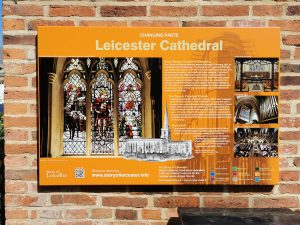Heritage panels

Recently featured on BBC TV was the unveiling in Leicester of ten more heritage panels explaining the history of Leicester. The ten panels detail locations and themes from the past, including John O’Gaunt’s Cellar at Leicester Castle. The BBC website tells us that the panels are part of the Story of Leicester project. The information panels have been commissioned by the city council to give residents and visitors the chance to find out more about the city’s past. This is from Roman times, through the Middle Ages, to the Victorian era and beyond.
The latest panels feature local landmarks including ‘The Cedars in Evington‘. This is an 1830s-built house which was home to the novelist Edward Phillips Oppenheim from the early 1900s. It was bought by All Saints Brewery and turned into a pub in 1938.
A panel also explains ‘The myths of the ancient John O’Gaunt’s cellar at Leicester Castle‘. This has been used as both a medieval dungeon and as a prison during the Napoleonic Wars.
A variety of panels
‘Evans Weir Industrial Area’. The heritage panel highlights how the canal system supported industrial growth in Leicester from the late 1700s.
‘All Saints Church’. Home to criminal trials in 1853. The ancient church also had a great clock that featured carved wooden Quarter Jacks that chimed on the hour.
‘GE-Thorn Lighting‘, built in 1939-40, it became one of the most important lamp factories in Britain.
‘Fielding Johnson Building‘. Now part of the University Of Leicester, the building was built in 1837 as the Leicestershire County Lunatic Asylum. It became a military hospital during the First World War.
‘A Coffee versus Ale’. This panel on High Street explores the Temperance Movement’s influence on the development of Leicester’s coffee houses.
‘Home for Penitent Females‘. Dating from 1881, the building on Stoneygate Road was paid for by local philanthropists to rehabilitate unmarried women or girls who had fallen into prostitution or become pregnant. The grade II-listed building later became a Montessori School.

‘Leicester Cathedral’. The original church of St Martin was built in the early 12th Century, possibly on the site of a much earlier Roman temple. It became Leicester’s cathedral in 1927 and became the final resting place of King Richard III in March 2015.”
A local connection
All the panels, with the exception of ‘Home for Penitent Women’ and ’Leicester Cathedral,’ were worked on by former parish clerk and Kibworth resident, Stephen Butt.
Stephen has been asked to seek places outside Leicester city centre where more of these panels can be sited to give added information to residents and visitors alike. If you know of such places please let us know and the Kibworth & District Chronicle can pass this information on.
Story of England
Kibworth has its own panels following ‘The Story of England’ television series back in 2010 however there isn’t a panel at the newly restored Kibworth Harcourt post mill which would help visitors. Perhaps the land owner might be interested in sponsoring such a panel to explain its workings and history.




 Poem of the month – Oct 22
Poem of the month – Oct 22

